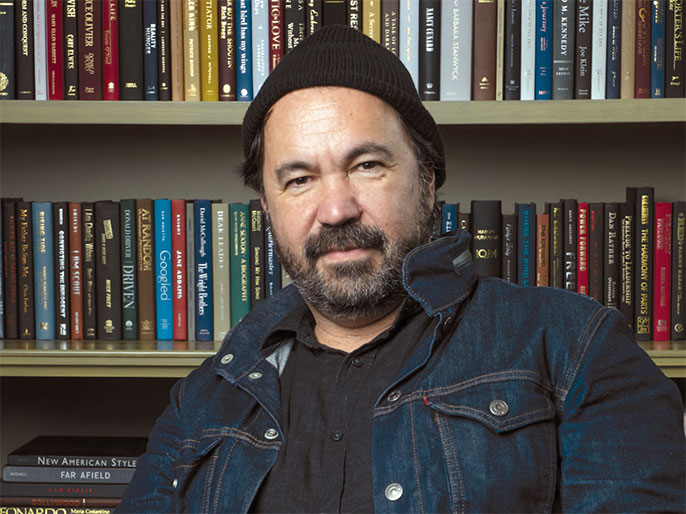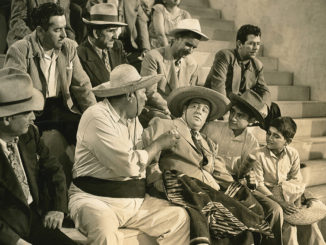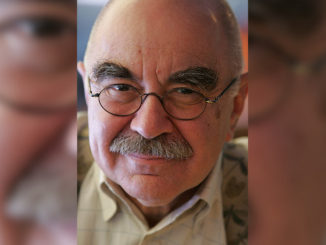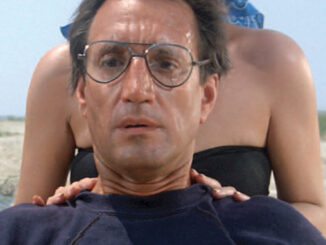
By Peter Tonguette
From the life and death of Karen Carpenter to our inability to function in the modern world to stories of love affairs thwarted by society, filmmaker Todd Haynes has always had a penchant for high drama.
His earlier films — including the aforementioned “Superstar: The Karen Carpenter Story” (1987), “Safe” (1995), and “Far from Heaven” (2002) — established that pattern, but his latest film confirms it. “May December” — which Netflix released to widespread attention and acclaim in late November — enlarges the sort of story that would normally be tabloid fodder to operatic proportions.
Julianne Moore (the earlier star of “Safe” and “Far from Heaven”) stars as Gracie, a woman whose life was derailed following the revelation of an illicit (and illegal) relationship with a teenager, Joe (Charles Melton) — a young man whom she subsequently married. Natalie Portman plays Elizabeth, an actress who has been tapped to play a character based on Gracie in a new movie.
The contours of Gracie’s crimes as depicted in Samy Burch’s screenplay are said to be inspired by the real-life case of Mary Kay Letourneau, who was the subject of a thousand newsmagazine segments in the 1990s and 2000s. In the hands of Haynes and his frequent collaborator in the cutting room, picture editor Affonso Goncalves, ACE, the material becomes as strange, disturbing, and darkly comic as anything in memory.
Over a series of collaborations reaching back to “Mildred Pierce” (2011) and including the acclaimed “Carol” (2015) and “Wonderstruck” (2017), Goncalves is uniquely attuned to Haynes’ style. The editor recently spoke with CineMontage about their latest cinematic undertaking.
CineMontage: You and Todd Haynes have worked together a long time. What about the two of you click?
Affonso Gonçalves: We watch films the same way and we like similar kinds of films. Todd has this encyclopedic knowledge of film, which is really amazing. We both have a deep love of film. We have that communication. He can make references and talk about movies that he loves and ideas that he has, and I know exactly what he’s talking about. I think that helps because then I know what he’s looking for.
For every single film we’ve worked together on, he’s done extensive research for the film. He has film references, music references, and literary references. He gives those to all of us — his main creative partners. It’s great, because you know what he’s going for, but it’s really fun because it enriches my knowledge of film and filmmaking.

CineMontage: What were some of the reference points for “May December”?
Gonçalves: He made a lot of references to [Ingmar] Bergman films, where he saw similarities — not only the mirror scenes, but films with women who mirror each other’s relationships. And [Jean-Luc] Godard and Joseph Losey. Then we started cutting, we kept thinking about those films.
Of course, this film has a very interesting tone. Ultimately, it’s a serious film with a serious subject matter — it’s a very morally dark and complex story — but it’s also funny. We had to shift. [Humor] not something we’re used to, or Todd is used to shooting, so it was really interesting in the cutting room for us to explore and, whenever we could, lean into the humor. And with a film like this, it really helps.
CineMontage: How did you bring that quality to the forefront?
Gonçalves: I think through the sharpness of the edit. In [Haynes’s] other films, there’s always sort of a lingering quality — the moments you get to experience and savor. Here, it’s a little bit different. We have so many scenes that are in one shot and things happen within the frame, and it is what it is; we just have to be careful when we’re coming in and we’re going out. Everything else has a little more pace, a little more sharpness. We get out a little faster than you expect. We talked about punchlines, which usually was not something that we’d talk about.
CineMontage: How do you and Todd work together? Do you cut as they’re shooting? What happens when Todd comes in?
Gonçalves: He’s shooting the film and I’m cutting. I was in LA, he was shooting in Savannah [Georgia]. When he finished shooting, I had a cut of the film. Todd doesn’t really watch dailies. He took a couple of weeks off. We sent to him DVDs of everything that was shot, so after he took a little break, he watched all the footage by himself and took notes, and he sent that all to me. By that time, I was in Portland, where he lives, so then I built a cut based on his notes. Then he came in and we worked off of that. We also had my cut, and we kind of used both of them.
Then that becomes the third cut, which is the final cut. It’s very hands-on. He comes in at 9 and he leaves at 7. We go through very, very detailed notes about every performance, every cut, the scenes, and the structure of the film. That part is similar in every film that we’ve done together.
CineMontage: Was “May December” a movie that changed a lot, or were the bones obvious from the beginning?
Gonçalves: The bones were there. It’s not a film that we did a massive restructure on. We lifted some scenes. We may have changed them a little bit around, or used different lines, but it was pretty close to the script. The work that we really did was work closely with performance, which is always something that we spend a lot of time on.
CineMontage: The movie is anchored by Julianne Moore and Natalie Portman. What was it like working with their performances?
Gonçalves: Once you pick one performance, everything else has to fall in line with that [within a scene]. It can’t be that one [performance] is too big and one is too small. Once we committed to Julianne’s performance, if the scene is anchored on her, everything else has to follow. Which is really interesting, because Natalie is kind of performing a performance by Julianne. Me and Todd have to really gauge: “Is this too much? Did she get it too close? Is the lisp too strong?” It’s really carefully building the right arc of the character and arc of the change.
CineMontage: Throughout the film, we hear the theme from Joseph Losey’s 1970 masterpiece “The Go-Between.” Was it a temp piece first? When did you decide to commit to that music?
Gonçalves: That emerged because Todd, while he was researching the film, decided to watch “The Go-Between.” It was a film that he really liked, and he hadn’t watched it in a long time. He immediately fell in love with the soundtrack to the point that he actually added it to the script. He also played it on the set for the actors.
I knew that we wanted to use [“The Go-Between”] as a temp, and I temped the film with it. It was really interesting because, when you watch [“May December”], it’s not something that comes to mind. One, it’s specific to the [Losey] film, and two, it has a specific sonic language that is not something you think of when you’re watching “May December.” The challenge was how do we fit this to the scene? So you sometimes cut in a way that’s going to fit, or you start the music a little later, or you don’t use the entire piece or just one hit.
CineMontage: There are a lot of colors to this film: it’s about moral issues, it’s also about show business and the media. What do you hope people take from the movie?
Gonçalves: I love the film. I feel like a lot of people are understanding the moral conundrums of the film. You come in with one idea, and it’s super-slippery because you can’t really trust the film — you have to make up your own mind of what’s right, what’s wrong, what is it that happened, and who was right. It’s so much about boundaries being trampled on.
As I’m working on it, I have to make my own decisions. I have to make my own judgment call. And, at the same time, I have to be true to the story and to the film, and I can’t pick sides. That’s the great thing about being an editor.






